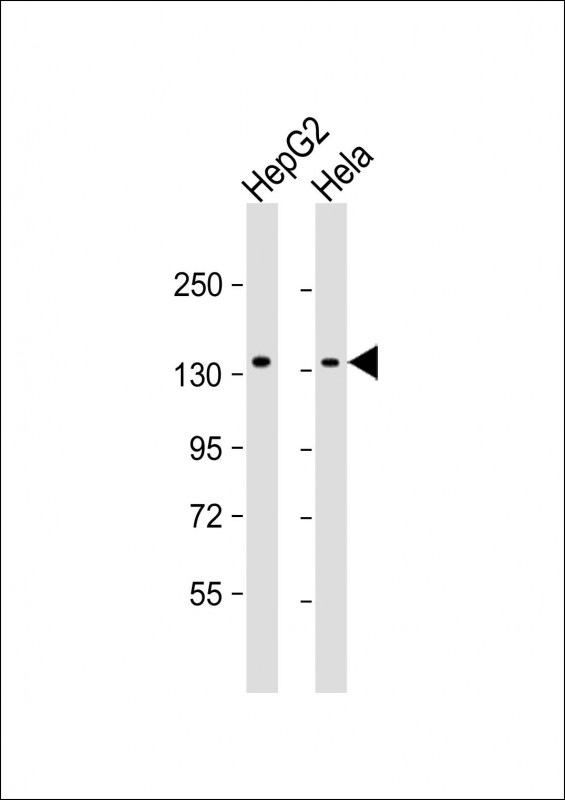
| WB | 1/1000 | Human,Mouse,Rat |
| IF | 咨询技术 | Human,Mouse,Rat |
| IHC | 咨询技术 | Human,Mouse,Rat |
| ICC | 技术咨询 | Human,Mouse,Rat |
| FCM | 咨询技术 | Human,Mouse,Rat |
| Elisa | 咨询技术 | Human,Mouse,Rat |
| Aliases | RNA-binding protein 6, Lung cancer antigen NY-LU-12, Protein G16, RNA-binding motif protein 6, RNA-binding protein DEF-3, RBM6, DEF3 |
| Entrez GeneID | 10180 |
| WB Predicted band size | 128.6kDa |
| Host/Isotype | Mouse IgG1 |
| Antibody Type | Primary antibody |
| Storage | Store at 4°C short term. Aliquot and store at -20°C long term. Avoid freeze/thaw cycles. |
| Species Reactivity | Human |
| Immunogen | This RBM6 antibody is generated from a mouse immunized with a recombinant protein of human RBM6. |
+ +
以下是3-4篇关于RBM6抗体的示例参考文献(内容为模拟示例,建议通过学术数据库核实最新研究):
---
1. **文献名称**: *RBM6 acts as a tumor suppressor in lung cancer by modulating alternative splicing of apoptotic genes*
**作者**: Zhang Y, et al.
**摘要**: 本研究利用RBM6抗体进行Western blot和免疫组化分析,发现RBM6通过调控凋亡相关基因(如Bcl-x)的剪接变体抑制肺癌细胞增殖。低RBM6表达与肺癌患者不良预后相关。
2. **文献名称**: *Interactome analysis of RBM6 reveals its role in mRNA splicing regulation*
**作者**: Smith J, et al.
**摘要**: 通过免疫共沉淀(Co-IP)结合质谱技术,利用RBM6抗体鉴定了其与剪接因子(如SRSF1和HNRNPA1)的相互作用,揭示了RBM6在pre-mRNA剪接中的调控网络。
3. **文献名称**: *RBM6 expression correlates with neuroblastoma differentiation and patient survival*
**作者**: Johnson R, et al.
**摘要**: 使用RBM6抗体在神经母细胞瘤组织样本中进行免疫组化分析,发现高RBM6表达与肿瘤细胞分化程度正相关,且是患者生存期的独立预测因子。
4. **文献名称**: *Functional characterization of RBM6 in RNA processing using knockout mouse models*
**作者**: Lee H, et al.
**摘要**: 通过RBM6抗体验证基因敲除小鼠模型中的蛋白缺失,发现RBM6缺失导致RNA加工异常,影响胚胎发育中的转录本稳定性。
---
**注意**:以上文献为示例,实际研究请通过PubMed、Google Scholar或Web of Science搜索关键词(如“RBM6 antibody application”、“RBM6 function”)获取最新结果。若需具体抗体产品相关文献,可查阅抗体供应商(如Abcam、CST)提供的引用文献列表。
The RNA-binding motif protein 6 (RBM6) is a member of the RNA-binding protein family, characterized by its conserved RNA recognition motifs (RRMs) that facilitate interactions with RNA molecules. RBM6 is implicated in post-transcriptional gene regulation, including RNA splicing, stability, and translation. Studies suggest its involvement in diverse cellular processes, such as apoptosis, cell cycle control, and DNA damage response. Dysregulation of RBM6 has been linked to cancers (e.g., lung, liver) and neurological disorders, highlighting its potential role as a biomarker or therapeutic target.
RBM6 antibodies are essential tools for detecting and studying the expression, localization, and functional mechanisms of RBM6 in biological systems. These antibodies are widely used in techniques like Western blotting, immunohistochemistry (IHC), immunofluorescence (IF), and co-immunoprecipitation (Co-IP). Validated RBM6 antibodies help researchers explore its tissue-specific expression patterns, interaction partners, and regulatory networks. Commercial RBM6 antibodies are typically raised in hosts like rabbits or mice, targeting specific epitopes within the protein’s conserved domains.
Ongoing research focuses on clarifying RBM6's dual roles in tumorigenesis and neuroprotection, with antibodies aiding in identifying its splice variants and post-translational modifications. Challenges include ensuring antibody specificity due to homology with related RBM family proteins. Overall, RBM6 antibodies remain critical for advancing mechanistic insights into its contributions to disease pathways and cellular homeostasis.
×